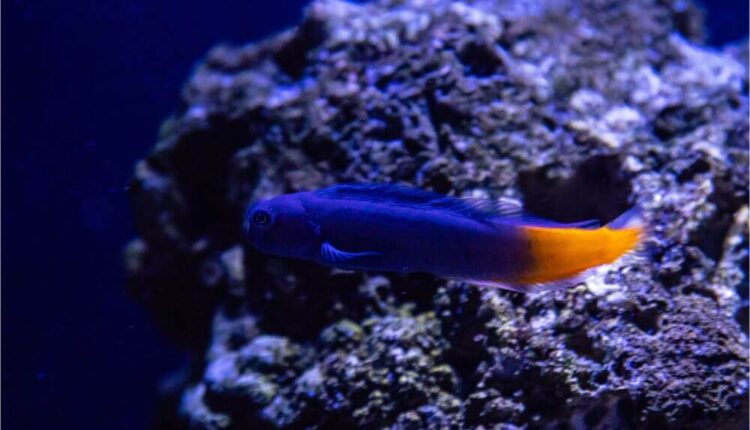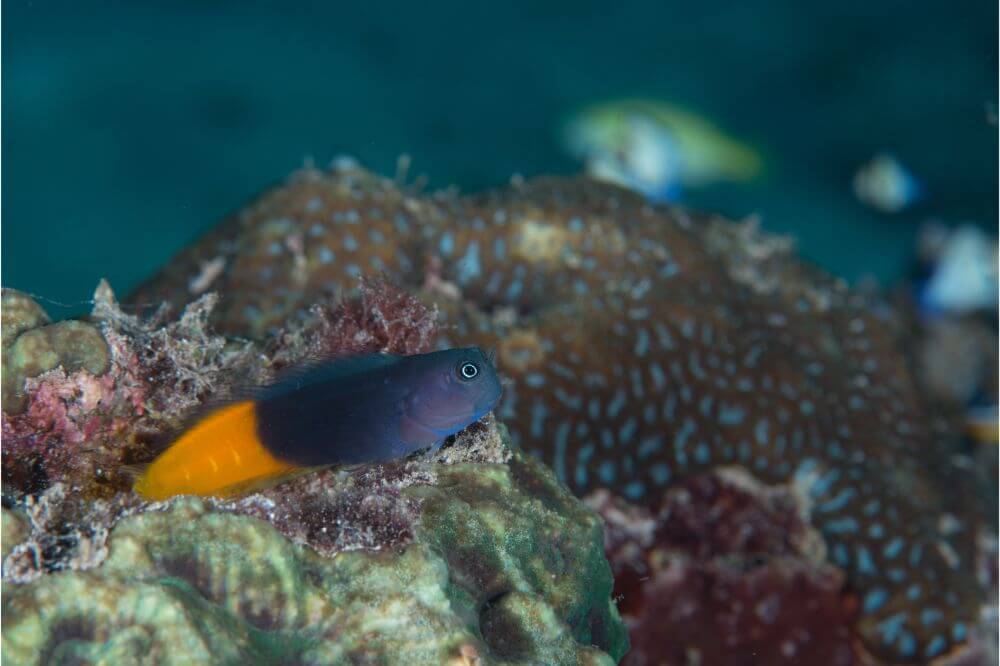Bicolor Blenny: A Guide to Care, Breeding, Diet & Behavior
Bicolor Blenny Complete Guide

When choosing the most beautiful fish for your aquarium, the Bicolor Blenny is one of the most popular options. Their scientific name is Ecsenius bicolor, and not only do they come in various colors, but they add a touch of beauty and brightness to your tank.
Moreover, it doesn’t cost or take too much to care for them, so you can easily house them in your aquarium.
The Bicolor Blenny is native to the waters near Fiji, Sri Lanka, and Indonesia. Let’s learn what there is to know about caring for Bicolor Blennies in this guide.
Lifespan
The expected lifespan for a Bicolor Blenny ranges between 2 to 4 years. However, they can probably live a year or two more if properly taken care of.
Appearance
All Bicolor Blennies come in two bright colors, which is why they are called bicolor. The front side of their body is a combination of blue, purple, and brown, while the back is of a gradient shade between orange and yellow.
They have a slim and long body with a long dorsal fin and two large protruding eyes with antennas. They often change colors during breeding.
Bicolor Blenny males are larger than the females. As a result, they have a brighter and slimmer appearance. Moreover, female Bicolor Blennies don’t have extended fin rays, and they also differ in the orange and yellow gradients.
Males have larger anal and dorsal fins than females. Lastly, males also have egg spots on their anal fin and thicker lips than the Bicolor Blenny female.
Size
Bicolor Blennies are generally small fish that exceed no more than 4 inches, even when mature.
Caring for a Bicolor Blenny
Caring for Bicolor Blennies involves providing them with a natural environment like in the wild. They spend most of their lives huddled around rocks in the lower level of the water, where they often feed on algae. Therefore, you should provide them with rock particles in the aquarium.
Commonly, Bicolor Blennies hide among the rocks and like to stay close to the bottom. However, they often feed on their kind, which is why it can be dangerous to fill up your aquarium with too many of them. Instead, ensure that you have a larger aquarium to accommodate them, i.e., a 30-gallon tank for one fish.
Moreover, Bicolor Blenny can be pretty sensitive to health conditions or environments, so it is essential for the water to be clean and replaced every few days.
They also prefer a water temperature between 23-27° Celsius and a pH between 8.1 and 8.4, which is more alkaline.
The water should have a calcium content of around 400 ppm, nitrate, and phosphate levels below 10 ppm, and magnesium content at approximately 1300 ppm to maintain the perfect environment for the Bicolor Blenny.
Experts also suggest keeping a lid on the aquarium at all times, as they can jump out.
Feeding Your Bicolor Blenny
Bicolor Blennies are strictly herbivores, and their diet ranges around a variety of plant-based food. This is why they usually stay near the bottom of the aquarium, where they feed on algae. You can feed them macro-algae, which provides them with the nutrients they need.
Bicolor Blennies need to feed on live algae to thrive, and they can die if they don’t get it for a few weeks. Therefore, you need to give them algae-based dry foods and freeze-dried meals that are given to herbivores.
They also need a lot of vitamins, for which you can cut garlic into small pieces and put it in their aquarium.
Make sure to lower food gently into the aquarium and not disturb them as they are feeding, as they are easily stressed.
Behavior and Temperament
Generally, Bicolor Blennies are calm and peaceful fish, frequently retiring to the bottom of the tank. However, they feed on other Blennies and smaller fish, so they need to be kept isolated from other fish.
If you have a large aquarium with many fish, make sure to put many rocks inside it, as they like to hop from one rock to another and don’t swim too much in larger tanks. Also, they are much less prone to eat their kind if they are in a larger space.
Additionally, the Bicolor Blenny is a target of larger fish, which is why you can’t have them inhabiting the same aquarium.
Bicolor Blenny Breeding
When it comes to breeding Bicolor Blennies, there are many challenges that you have to navigate through, one of which is laying eggs.
Place the male and female Bicolor Blenny in one tank. They will often start fighting with each other but will soon mate and lay eggs.
To determine if they are spawning, observe if both the male and female have hidden among the rocks or other hiding places. Another sign of mating is that the male fish will undergo a color change and turn a darker blue shade.
In a few days, the eggs start to hatch, and this is when you have to be extra careful with the water conditions and diet. Unfortunately, Bicolor Blenny babies often die due to improper care.
Make sure to feed the babies with only microscopic aquatic animals, such as rotifers. Moreover, change at least 10 percent of the water daily.
Conclusion
Although the Bicolor Blenny is one of the most beautiful fish you can have in your aquarium, there are certain challenges you must navigate to ensure that they thrive and stay healthy.
Make sure you have a large aquarium, and don’t fill it up with too many of the same species as it can result in them feeding on each other. However, with just a little care and caution, and you can easily keep Bicolor Blennies in your aquarium for years.

